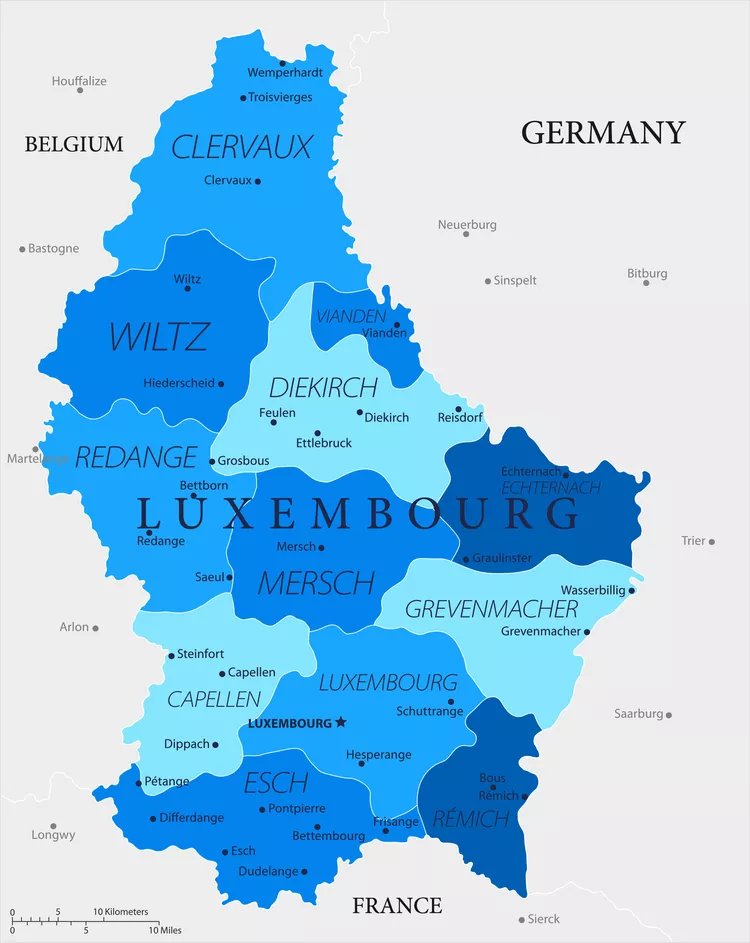Summary of Luxembourg Guide
Luxembourg Overview
Luxembourg is a small yet captivating country located in the heart of Europe. It serves as the “lux” in Benelux, a region that includes Belgium and the Netherlands. Bordered by France, Germany, and Belgium, this petite nation spans just 51 miles long and 32 miles wide, boasting a population of fewer than 500,000 residents. Moreover, Luxembourg is rich in rivers, with the most significant being the Moselle, the Sûre, the Our, and the Alzette.
- Weather and When to Visit: The weather is moderated by the sea located about 200 miles to the north. Summers can be pleasantly warm, but expect about 10-13 rain days each month. The best time to visit is during spring when wildflowers bloom abundantly.
- Currency: Luxembourg uses the Euro.
- Languages: Luxembourgish, known as “Lëtzebuergesch,” is the national language. French and German are also widely spoken and recognized as the official languages.
- Tipping: A service charge of 15% is typically included in restaurant bills. While tipping isn’t obligatory, leaving an extra Euro or two for exceptional service is common.
- Shopping: Visitors can explore Villeroy & Boch’s crystal factories in the village of Septfontaines.
Regional Map and Key Attractions
This map illustrates the regions of Luxembourg that are of interest to visitors:
- The Ardennes: This mountainous region, extending from southeast Belgium, is lush with forests and rolling hills, showcasing compelling castles such as Vianden Castle.
- The Luxembourg City Area: This area includes Luxembourg’s capital, a city teeming with history and culture.
- The Mullerthal: Often referred to as “Little Switzerland,” it features unique rock formations, scenic waterfalls, and diverse vegetation.
- Red Rocks: Known as Les Terres Rouge, this area, once an iron mining hub, is now home to hiking trails amidst the reclaimed natural beauty.
- The Moselle Region: Famous for its exquisite white wines, this picturesque region is a must-visit for wine enthusiasts.
Transportation in Luxembourg
Driving in Luxembourg
Luxembourg boasts an exceptional road system. While country roads may be narrower than those in the U.S., their maintenance is impeccable. Fuel prices here are often cheaper than in neighboring countries, with all highways being free of tolls. Remember to wear your seatbelt while driving.
Public Transport
Luxembourg’s extensive rail and bus network is operated by CFL, or the Chemins de Fer Luxembourgeois. Travelers can access electrified railways and buses throughout the country, allowing for seamless transportation.
Travel on the rail and bus network is complimentary with the Luxembourg Card.
Air Travel
The national airline, Luxair, serves as the primary carrier for flights to and from Luxembourg, with Luxembourg International Airport (Findel Airport) located just 4 km northeast of Luxembourg City.
Distances from Luxembourg City to Other Tourist Destinations

For those incorporating Luxembourg into a broader European trip, consider these distances to key destinations:
- Trier, Germany: 40.7 km
- Dinant, Belgium: 113 km
- Liege, Belgium: 131 km
- Cologne, Germany: 160 km
- Karlsruhe, Germany: 177 km
- Brussels, Belgium: 187 km
- Frankfurt, Germany: 190 km
- Basel, Switzerland: 252 km
- Paris, France: 287 km





